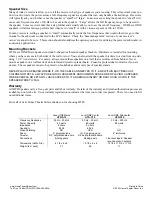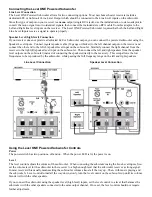
Level ONE Speakers
Models: HTD-A10, HTD-C10, HTD-S10
Owner’s Manual
Welcome to the HTD family of satisfied customers. We thank you for giving us the chance to win your business. To
ensure you get the most out of your new speakers, please take a moment to read this manual before you get started.
Should you lose this manual, you can always download a copy for free from our website.
A Few Words About Stereo and Home Theater
HTD speakers are designed to accurately reproduce high fidelity music as well as dialogue and effects in movies. Most of
us are familiar with the concept of 2-channel audio, commonly known as stereo. In a home theater environment,
recording engineers have the option of recording into additional channels. Most of today’s movies are recorded in 5.1
surround sound formats, most often either Dolby Digital or DTS. When these movies are played with a digital source,
such as a DVD player, audiences at home have the opportunity to hear all of these channels if their system has been
equipped with the appropriate speakers for each channel. When these movies are played through an analog source, such
as a VCR, the 5.1 surround signal has been converted to other analog formats, most often Dolby ProLogic. Dolby
ProLogic will make use of the same 5.1 speaker channels, although the back two (surround) speakers will receive the
identical channel of information and it is not a full range signal. The subwoofer is provided the low frequencies sent to
the other channels in a Dolby ProLogic recording. By contrast, a true 5.1 digital recording includes a completely unique
channel of both low frequencies and effects (LFE). This channel is called the LFE channel and represents the .1 in a 5.1
system. In most of today’s receivers, the five full frequency channels- front right, front center, front left, rear (surround)
right, and rear (surround) left- are “powered” channels, meaning the receiver has built-in amplification for each channel.
By contrast, the LFE channel is most often not powered. And because this channel only produces the lowest frequencies,
a powered subwoofer is necessary to reproduce the LFE channel.
Hooking Up Your Speakers
HTD Level ONE Speakers include gold-plated, push-type binding posts. The gold-plated binding posts ensure an
efficient transfer of signal and power from any standard type of cable or wire connector, including bare wire. For bare
wire or pin-type connectors, press down on the post to reveal an “eye”. Simply thread the wire or pin through the eye and
release so that the binding post securely tightens around the wire or pin. Individual or paired banana plugs can be inserted
directly into the holes at the mouth of the collar with a snug fit.
When connecting the speakers, it is very important to retain the correct polarity. This means that the wire attached to the
+, red, or positive terminal on one component must be attached to the +, red, or positive terminal on the corresponding
component’s speaker output terminals. Similarly, the -, black, or negative terminals must connect to the respective -,
black, or negative terminals.
See “Hooking Up the Level ONE Powered Subwoofer” for details on connecting the subwoofer.
Speaker Placement
All three of the front speakers- left, center, right – are intended to be directional and should be placed at approximately the
same height and distance from the ideal listening spot. The center speaker is video shielded so that the magnets inside do
not interfere with picture performance. It should be placed as close to the television as possible, so that the audio appears
to come straight out of the picture. The front left and right speakers should be placed far enough from the television to
ensure that you can distinguish sounds coming from the left and right. Typically, placing the front left and right speakers
between seven and twelve feet apart is appropriate. At a minimum, the Level ONE Main Speakers should be placed at
least two feet from a picture tube as they are not video shielded. Many audio enthusiasts recommend aiming the speakers
such that the angle created by drawing a line from one speaker to the listener and back to the other speaker is a 45-degree
angle. This setting generally mimics the condition set by the mixer at the film studio.
Place the surround speakers about as close to the ideal listening spot as you placed the front left and right speakers, and
about the same height or higher. This of course is only a guideline. The size and shape of your room will almost certainly
dictate a modification to the “ideal” set-up. Volume adjustments within the receiver will help balance your system.
Because it is difficult to distinguish the direction from where lower frequencies are created, you can place the subwoofer
nearly anywhere in the room. Placing the subwoofer closer to a corner or wall will increase the level of bass produced but
may also muddy the sound. You should experiment with different positions before settling on the one you prefer.






















